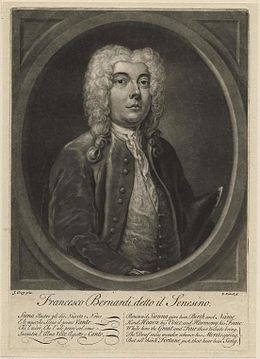Senesino
| Naissance | |
|---|---|
| Décès | |
| Activités |
| Tessiture | |
|---|---|
| Genre artistique |

Francesco Bernardi, dit Senesino ou Il Senesino, est un castrat contralto italien, né à Sienne le et mort dans la même ville le le [1].
Éléments biographiques
[modifier | modifier le code]Senesino[2] tira son surnom de sa ville natale, Sienne. Il fit ses débuts en 1707 à Venise. En 1717, il fut engagé par l'Opéra de la cour de Dresde, où Georg Friedrich Haendel l'entendit chantant dans Teofane de Lotti. Senesino fut congédié de son emploi à Dresde après avoir déchiré la partition d'un autre chanteur sur scène. Haendel l'engagea alors pour chanter à l'Académie Royale de Musique à Londres. Il resta au service de l'Académie et eut un rôle fondamental dans les opéras de Haendel. Il rejoignit cependant la troupe rivale, le Nobility Opera, au sein de laquelle il chantera avec Farinelli et le compositeur Porpora peu de temps avant la faillite des deux compagnies en 1733. Il a ensuite été engagé par Jean-Laurent de La Viéville, seigneur de Francine, directeur de l'Académie Royale de Musique, pour donner douze concerts dès juillet 1723[3].
Rôles interprétés
[modifier | modifier le code]Senesino créa le rôle-titre ou l'un des rôles principaux de nombreux opéras de Haendel, dont :
- Giulio Cesare in Egitto (rôle-titre)
- Andronico (dans l'opéra Tamerlano)
- Bertarido (dans l'opéra Rodelinda)
- Scipio (Scipion)
- Admeto (rôle-titre)
- Alessandro (rôle-titre)
- Poro (rôle-titre)
- Sosarme
- Ezio (rôle-titre)
- Orlando (rôle-titre)
- Guido (dans l'opéra Flavio)
Il incarne également Lotario, empereur germanique dans Carlo re d'Allemagna d'Alessandro Scarlatti, lors de sa création napolitaine en .
Notes
[modifier | modifier le code]- Vickers, David und Vitali, Carlo: Senesino. In: Landgraf, Annette und Vickers, David: The Cambridge Handel Encyclopedia, Cambridge University Press 2009, (ISBN 978-0-521-88192-0), p. 581.
- Du moins deux autres castrats natifs de Sienne, Andrea Martini et Giusto Fernando Tenducci, ont porté le même surnom. Bernardi est cependant le plus connu.
- (en) Lowell Lindgren, « PARISIAN PATRONAGE OF PERFORMERS FROM THE ROYAL ACADEMY OF MUSICK (1719–28) », Music and Letters, vol. 58, no 1, , p. 4–28 (ISSN 0027-4224 et 1477-4631, DOI 10.1093/ml/58.1.4, lire en ligne, consulté le )
Liens externes
[modifier | modifier le code]
- Ressources relatives à la musique :
- Ressources relatives aux beaux-arts :
- Notices dans des dictionnaires ou encyclopédies généralistes :
Text is available under the CC BY-SA 4.0 license; additional terms may apply.
Images, videos and audio are available under their respective licenses.

